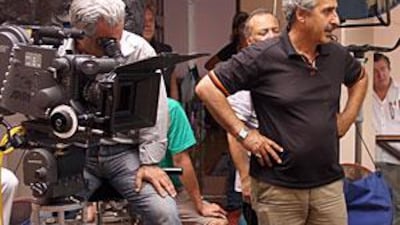NEW YORK // As Washington and Tehran perform a diplomatic dance over Iran's suspected nuclear weapons programme, one group of Iranian filmmakers has benefited from the apparent thaw in relations between the long-standing enemies. Masoud Jafari Jozani, an Iranian director, secured a dozen visas to enter the United States and film a movie. "This would have been unheard of a year ago," said Jozani, who is filming In the Wind's Eye in California. He described his Iranian crew as the first such group of film-makers granted entry to the United States since the Islamic Revolution in 1979.
Philippe Diaz, the founder of Cinema Libre Studio, the Los Angeles-based film company that assisted the transatlantic shoot, said US movie moguls had previously balked at the idea of joining hands with a Tehran production. "After eight years of Bush, it was unlikely that anybody in Hollywood would partner with an Iranian team and make an Iranian-financed movie. That's why we got involved," Mr Diaz said. "The Bush administration refused visas to artists from Iran, Cuba or anyone they considered a rogue state."
The enmity between the two countries dates to the revolution, which saw Iran's western-backed monarchy toppled and 52 US citizens held hostage in Tehran for 444 days. George W Bush, included Iran in his 2002 State of the Union address, calling it part of an "axis of evil". But during a landmark speech to the Muslim world in Cairo in June, Barack Obama spoke of a willingness to "overcome decades of mistrust" in prelude to a cautious detente between the rivals.
In the run-up to this month's UN General Assembly meeting, the two countries have engaged in delicately choreographed diplomacy over Iran's nuclear programme, which Tehran insists will be used only for civilian purposes. Despite being rebuffed in the past, Jozani took Mr Obama's policy shift as an opportunity to head to the US Embassy in Dubai and apply for visas to shoot a feature-length conclusion to his hit television series.
"You could feel the change since Obama became president," Jozani said during a telephone interview after finishing his 40-day shoot in Los Angeles. "The embassy staff was very respectful of our crew and issued the visas without any hassle." The film continues Jozani's 52-hour epic series, Dar Chashme Baad, which takes audiences through six decades of turbulent Iranian history in a melodramatic saga replete with large-scale battle scenes. Casting a narrative from after the First World War through Iraq's 1980 invasion of Iran, the drama unfolds around Bijan, an Iranian driven from his war-affected homeland in 1945 to a new life in the United States.
Decades later, Bijan lives in Los Angeles, where the middle-aged neurologist and lecturer receives a letter from a woman claiming to be his wife, whom he believed had died at the hands of the Soviet army. The protagonist must then decide whether to leave his fiancée and cushy California lifestyle and return to his apparent wife and son in Iran, while the country is poised on the brink of war with Iraq. "He is an ordinary, honest man faced with extraordinary circumstances," said Parsa Pirouzfar, the lead actor. "His life in Iran takes place around war and turmoil, and when he gets to America he wants to forget about this past. But his past comes back."
Mr Diaz describes impressive co-operation between the Iranian team and their US counterparts. On-set camaraderie shown by grips (lighting technicians), sound technicians and make-up artists - who used mime, grace and good humour to bridge the gap between Farsi and English - offers a potent message in cross-cultural relations, he said. "Artistic projects can open doors and change mentalities," he said. "We can't change the policies of rulers in Washington and Tehran, but we can show that there is not much difference between Iranian and American people. We are all people; we are all the same and when we work together, it works."
Iranian filmmaking, long admired by Farsi-speaking audiences and movie buffs in the West, has remained a flourishing industry since the revolution but, Jozani's crew say, it is markedly alien to Hollywood. "The [US] industry is well established and they have ready-built sets and costumes from many different time periods. In Iran, everything has to be custom-made," said Majid Mirfakhraei, a production designer.
In Hollywood, Mirfakhraei's role is split into jobs for storyboard artists, set designers, a wardrobe unit and special effects - pushing US productions well in excess of the budget of US$12 million (Dh44m) spent on In the Wind's Eye. The team has several days of filming in San Francisco before entering the editing suites, but Jozani is assured his film will succeed in Iran, where he is an established moviemaking name.
The director and writer hopes his magnum opus, what he calls the "longest-running and most expensive production in Iranian film history", will also offer crowds in the United States a different perspective on life in the Middle East when it screens at independent cinemas. "Americans are curious about the way we live in the Middle East. Although we are very cultured people, we have experienced great trouble and turmoil for the past 40 years," he said.
"In American movies, we are always portrayed as the bad guys. But a true story like this will show them how we live, how we care about each other and how we love our families. They will see that the turmoil comes about through international relations and wars over petroleum." jreinl@thenational.ae


